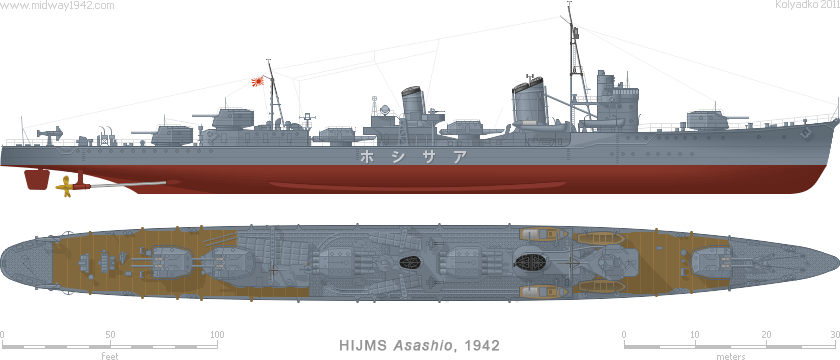
| Asashio class, 朝潮型 | DESTROYERS, 駆逐艦 | |

| Displacement: | 2,370 t (1,961 t Std) | Machinery: | 3 boilers, 2 shafts | DP Guns: | 3×2×5 in (127 mm)/50 | |||||||
|---|---|---|---|---|---|---|---|---|---|---|---|---|
| Max Length: | 388 ft 1 in | 118.3 m | Max Power: | 50,000 hp | 37 285 kW | AA Guns: | 2×2×.98 in (25 mm) | |||||
| Beam: | 33 ft 10 in | 10.3 m | Max Speed: | 35 kts | 65 km/h | Torpedo Battery: | 2×4×24 in (610 mm) tubes | |||||
| Draght: | 12 ft 2 in | 3.7 m | Range: | 5,700 nm | 10 556 km | Depth Charges: | 2 throwers, 16 charges | |||||
| Complement: | 200 officers & enlisted | Bunkerage: | 500 t fuel oil | Sensors: | Sonar | |||||||
* Armament as during the Battle of Midway (June 1942).
By the mid-1930s the Imperial Japanese Navy was not satisfied with the performance of the 1500-ton Hatsuharu and Shiratsuyu classes destroyers in terms of fire-power, stability, operational range, and speed against previous “special type” destroyers of Fubuki and Akatsuki classes. It was possible to fulfill new requirements only at the expense of displacement growth that would exceed the limits established by the 1930 London Naval Treaty, but by this time the Japanese government allowed the Treaty to expire without renewal, so the larger new Asashio class ships were approved in 1934, and their design subsequently became the basic plan for all future Japanese destroyers.
The Asashio class destroyers were designed to take advantage of Japan’s lead in torpedo technology. Eight 24 in (610 mm) torpedo tubes in two quadruple centerline mounts carried the lethal Type 93 “Long Lance” torpedoes. The containers with eight spare torpedoes placed behind the mounts made possible their reloading underway within а few seconds, therefore the practical power of the Asashio's torpedo battery surpassed even U.S. destroyers armed with twice as many torpedo tubes. The artillery armament consisted of six 5 in (127 mm) dual-purpose guns mounted in twin splinter-proof turrets. Asashio class ships also became the first Japanese destroyers armed with new .98 in (25 mm) anti-aircraft autocannons in two twin mounts, and to be equipped with sonar.
Two Asashio class destroyers (DD-76 Asashio and DD-79 Arashio) took part in the Battle of Midway as destroyer screen of Close Support Force.
| Ship | Builder | Laid Down | Launched | Commisioned | Fate | ||||||||||||||
|---|---|---|---|---|---|---|---|---|---|---|---|---|---|---|---|---|---|---|---|
| DD-76 | 朝潮 | Asashio | Naval Arsenal, Sasebo | 7 | Sep | 1935 | 16 | Dec | 1936 | 31 | Aug | 1937 | Sunk in action | 4 | Mar | 1943 | |||
| DD-77 | 大潮 | Ōshio | Naval Arsenal, Maizuru | 5 | Aug | 1936 | 19 | Apr | 1937 | 31 | Oct | 1937 | Sunk in action | 20 | Feb | 1943 | |||
| DD-78 | 満潮 | Michishio | Fujinagata Shipbuilding | 5 | Nov | 1935 | 15 | Mar | 1937 | 31 | Oct | 1937 | Sunk in action | 25 | Oct | 1944 | |||
| DD-79 | 荒潮 | Arashio | Kawasaki, Kobe | 1 | Oct | 1935 | 26 | May | 1937 | 30 | Dec | 1937 | Sunk in action | 4 | Mar | 1943 | |||
| DD-80 | 夏雲 | Natsugumo | Naval Arsenal, Sasebo | 1 | Jul | 1936 | 26 | May | 1937 | 10 | Feb | 1938 | Sunk in action | 15 | Oct | 1942 | |||
| DD-81 | 山雲 | Yamagumo | Fujinagata Shipbuilding | 4 | Nov | 1936 | 24 | Jul | 1937 | 15 | Jan | 1938 | Sunk in action | 25 | Oct | 1944 | |||
| DD-82 | 峯雲 | Minegumo | Fujinagata Shipbuilding | 22 | Mar | 1937 | 4 | Nov | 1937 | 30 | Apr | 1938 | Sunk in action | 5 | Mar | 1943 | |||
| DD-83 | 朝雲 | Asagumo | Kawasaki, Kobe | 23 | Dec | 1936 | 5 | Nov | 1937 | 31 | Mar | 1938 | Sunk in action | 25 | Oct | 1944 | |||
| DD-84 | 霰 | Arare | Naval Arsenal, Maizuru | 5 | Mar | 1937 | 16 | Nov | 1937 | 15 | Apr | 1939 | Sunk in action | 5 | Jul | 1942 | |||
| DD-85 | 霞 | Kasumi | Uraga Dock Company | 1 | Dec | 1936 | 18 | Nov | 1937 | 24 | Jun | 1939 | Sunk in action | 7 | Apr | 1945 | |||